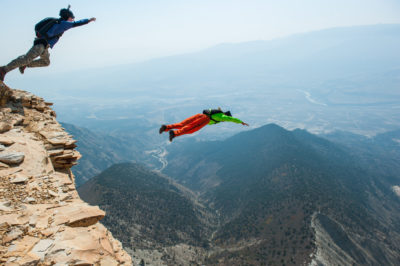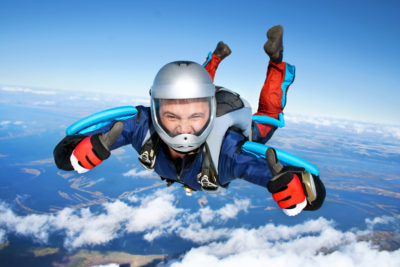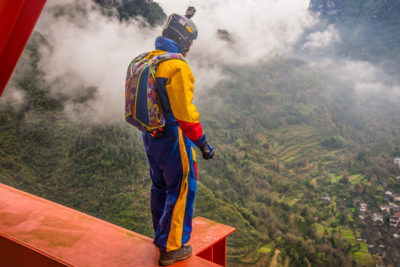- Michigan's Premier Skydiving Center
- Call Now: (517) 423-7720
What is BASE Jumping?
Thursday, March 31, 2022
- Skydive Tecumseh
- 3/31/22
- 0
- Blog, General
The internet is filled with some pretty incredible things. If you’ve been scouring the world wide web long enough, you’ve probably come across at least a few epic videos of amazing athletes leaping from cliffsides, mountain ridges, and the tippy-tops of skyscrapers. In the skydiving industry, we refer to these kinds of escapades as BASE jumps.
Interested in learning more about these death-defying stunts? Keep reading as we cover what exactly BASE jumping is, the differences between skydiving and BASE jumping, and how to start BASE jumping (though after reading and learning a bit more, you may not want to!).
BASE Jumping: What is it?
BASE is actually an acronym that stands for Building, Antennae, Span (think bridge), and Earth (usually tall cliffs). These letters represent the four primary “exit points” that BASE jumpers leap from.

Skydiving vs BASE Jumping
There are a number of differences between skydiving and BASE jumping. Although, you will rarely find a BASE jumper that has not first tasted flight with skydiving. In fact, the majority of reputable BASE first jump courses require that participants are experienced skydivers and have completed between 200 and 500 jumps. Though this required range is not a hard-and-fast rule, BASE schools may put emphasis on skills rather than jump numbers.
In general, these pre-BASE jump requirements are in place to ensure that BASE participants have enough experience with the aerodynamics of parachute flight in order to be able to land safely in tight spaces–which is what the majority of BASE jumps will require. (Imagine leaping from the top story of a building and needing to land on a tiny section of the busy street below–that’s going to require some serious parachute chops!)

One Parachute vs Two Parachutes
One key difference between skydiving vs BASE jumping is the number of parachutes available. In BASE jumping, individuals use a single-parachute system. This single parachute is packed within a fairly simple fabric “backpack”. These parachuting systems are not regulated by any organization or government authority.
Skydiving, in contrast, utilizes a fairly complex system. The Federal Aviation Administration requires that a dual-parachute system is used for skydiving, meaning that the skydiving container (backpack) contains two parachutes: a main parachute and a reserve parachute. These systems often also include an uber precise computer called an Automatic Activation Device. When certain parameters of altitude and speed are met, this engineering marvel automatically deploys the reserve parachute.
Exit Altitude
Another difference between skydiving and BASE jumping is the altitude of the exit point. In skydiving, full-altitude skydives are typically completed between 9,000 and 14,000 feet, with high-altitude skydiving options occurring from about 18,000 feet. In the industry, low-altitude skydives often referred to as hop-n-pops, are completed anywhere from 3,500 to 5,000 feet. Conversely, BASE jumps are usually completed from an altitude of 486 feet or less.

Less Margin For Error
Let there be no doubts about it: skydiving has its risks, but BASE jumping is overtly dangerous. Because of the low altitude that BASE jumps are completed from, these jumpers have just a few seconds to orient their bodies before deploying their single parachute.
Furthermore, many BASE jumps are made into less-than-ideal landing areas, often rocky, natural settings or, in the case of buildings and antennas, areas bordered by power lines and in close proximity to moving traffic. Each of these elements increases the dangers involved in BASE jumping exponentially.
How To Start BASE Jumping
Individuals who are interested in BASE jumping are encouraged to begin skydiving first. Many times these would-be students meet BASE mentors within the skydiving community.
Before pursuing BASE jumping, it’s important to focus on a stable body position while skydiving and to perfect your canopy flight skills. Once the time is right and you feel like you’ve got your skills dialed in, ask around the dropzone – you’ll likely find someone to steer you to your BASE first jump course!
Still haven’t explored the wild blue yonder? Contact us to schedule your first tandem skydive today!

Wonderful staff -- my tandem instructor, James, was funny, clear, and made sure that I was comfortable during the entire experience (which involved two flights and a bit of "will-we-or-won't-we" due to clouds).
The dive itself is unreal -- exhilarating and meditative, terrifying and relaxing, absolutely breathtaking. I absolutely recommend you try it here first. Skydive Tecumseh has a great reputation, and there's a reason for that. I hope to go again.
John Maguire
Copyright © 2025, Skydive Tecumseh, All Rights Reserved.
DropZone Web Design & Marketing by Beyond Marketing, LLC